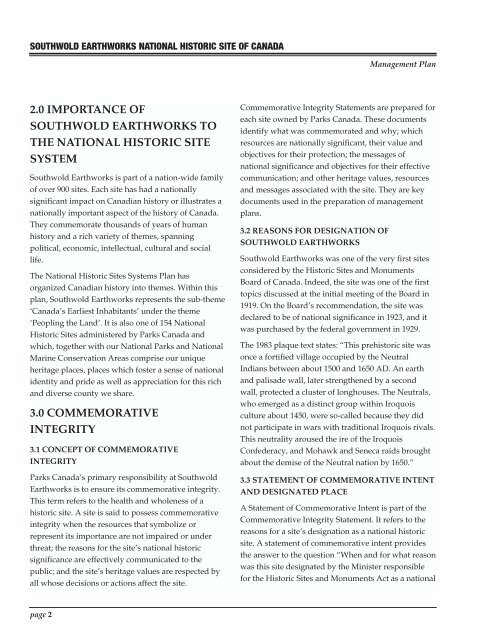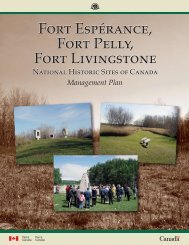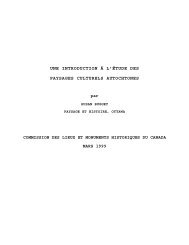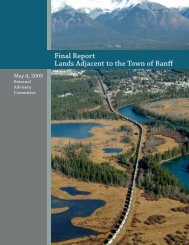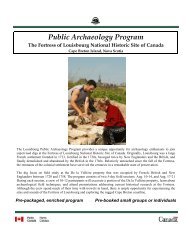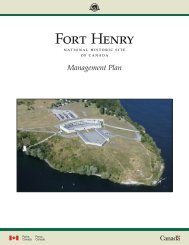Southwold Earthworks National Historic Site of Canada ...
Southwold Earthworks National Historic Site of Canada ...
Southwold Earthworks National Historic Site of Canada ...
You also want an ePaper? Increase the reach of your titles
YUMPU automatically turns print PDFs into web optimized ePapers that Google loves.
SOUTHWOLD EARTHWORKS NATIONAL HISTORIC SITE OF CANADA<br />
Management Plan<br />
2.0 IMPORTANCE OF<br />
SOUTHWOLD EARTHWORKS TO<br />
THE NATIONAL HISTORIC SITE<br />
SYSTEM<br />
<strong>Southwold</strong> <strong>Earthworks</strong> is part <strong>of</strong> a nation-wide family<br />
<strong>of</strong> over 900 sites. Each site has had a nationally<br />
significant impact on Canadian history or illustrates a<br />
nationally important aspect <strong>of</strong> the history <strong>of</strong> <strong>Canada</strong>.<br />
They commemorate thousands <strong>of</strong> years <strong>of</strong> human<br />
history and a rich variety <strong>of</strong> themes, spanning<br />
political, economic, intellectual, cultural and social<br />
life.<br />
The <strong>National</strong> <strong>Historic</strong> <strong>Site</strong>s Systems Plan has<br />
organized Canadian history into themes. Within this<br />
plan, <strong>Southwold</strong> <strong>Earthworks</strong> represents the sub-theme<br />
‘<strong>Canada</strong>’s Earliest Inhabitants’ under the theme<br />
‘Peopling the Land’. It is also one <strong>of</strong> 154 <strong>National</strong><br />
<strong>Historic</strong> <strong>Site</strong>s administered by Parks <strong>Canada</strong> and<br />
which, together with our <strong>National</strong> Parks and <strong>National</strong><br />
Marine Conservation Areas comprise our unique<br />
heritage places, places which foster a sense <strong>of</strong> national<br />
identity and pride as well as appreciation for this rich<br />
and diverse county we share.<br />
3.0 COMMEMORATIVE<br />
INTEGRITY<br />
3.1 CONCEPT OF COMMEMORATIVE<br />
INTEGRITY<br />
Parks <strong>Canada</strong>’s primary responsibility at <strong>Southwold</strong><br />
<strong>Earthworks</strong> is to ensure its commemorative integrity.<br />
This term refers to the health and wholeness <strong>of</strong> a<br />
historic site. A site is said to possess commemorative<br />
integrity when the resources that symbolize or<br />
represent its importance are not impaired or under<br />
threat; the reasons for the site’s national historic<br />
significance are effectively communicated to the<br />
public; and the site’s heritage values are respected by<br />
all whose decisions or actions affect the site.<br />
Commemorative Integrity Statements are prepared for<br />
each site owned by Parks <strong>Canada</strong>. These documents<br />
identify what was commemorated and why; which<br />
resources are nationally significant, their value and<br />
objectives for their protection; the messages <strong>of</strong><br />
national significance and objectives for their effective<br />
communication; and other heritage values, resources<br />
and messages associated with the site. They are key<br />
documents used in the preparation <strong>of</strong> management<br />
plans.<br />
3.2 REASONS FOR DESIGNATION OF<br />
SOUTHWOLD EARTHWORKS<br />
<strong>Southwold</strong> <strong>Earthworks</strong> was one <strong>of</strong> the very first sites<br />
considered by the <strong>Historic</strong> <strong>Site</strong>s and Monuments<br />
Board <strong>of</strong> <strong>Canada</strong>. Indeed, the site was one <strong>of</strong> the first<br />
topics discussed at the initial meeting <strong>of</strong> the Board in<br />
1919. On the Board’s recommendation, the site was<br />
declared to be <strong>of</strong> national significance in 1923, and it<br />
was purchased by the federal government in 1929.<br />
The 1983 plaque text states: “This prehistoric site was<br />
once a fortified village occupied by the Neutral<br />
Indians between about 1500 and 1650 AD. An earth<br />
and palisade wall, later strengthened by a second<br />
wall, protected a cluster <strong>of</strong> longhouses. The Neutrals,<br />
who emerged as a distinct group within Iroquois<br />
culture about 1450, were so-called because they did<br />
not participate in wars with traditional Iroquois rivals.<br />
This neutrality aroused the ire <strong>of</strong> the Iroquois<br />
Confederacy, and Mohawk and Seneca raids brought<br />
about the demise <strong>of</strong> the Neutral nation by 1650.”<br />
3.3 STATEMENT OF COMMEMORATIVE INTENT<br />
AND DESIGNATED PLACE<br />
A Statement <strong>of</strong> Commemorative Intent is part <strong>of</strong> the<br />
Commemorative Integrity Statement. It refers to the<br />
reasons for a site’s designation as a national historic<br />
site. A statement <strong>of</strong> commemorative intent provides<br />
the answer to the question “When and for what reason<br />
was this site designated by the Minister responsible<br />
for the <strong>Historic</strong> <strong>Site</strong>s and Monuments Act as a national<br />
page 2


